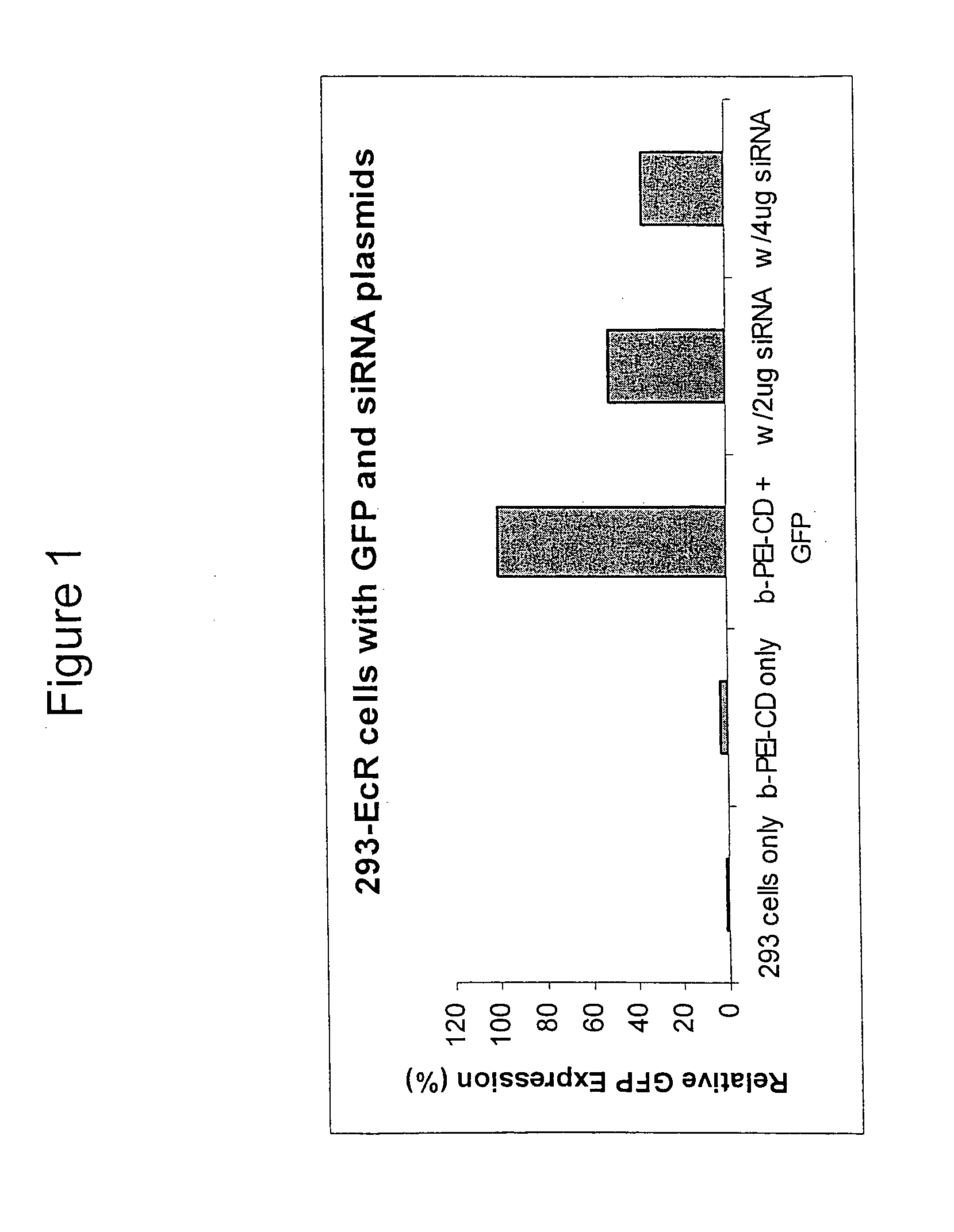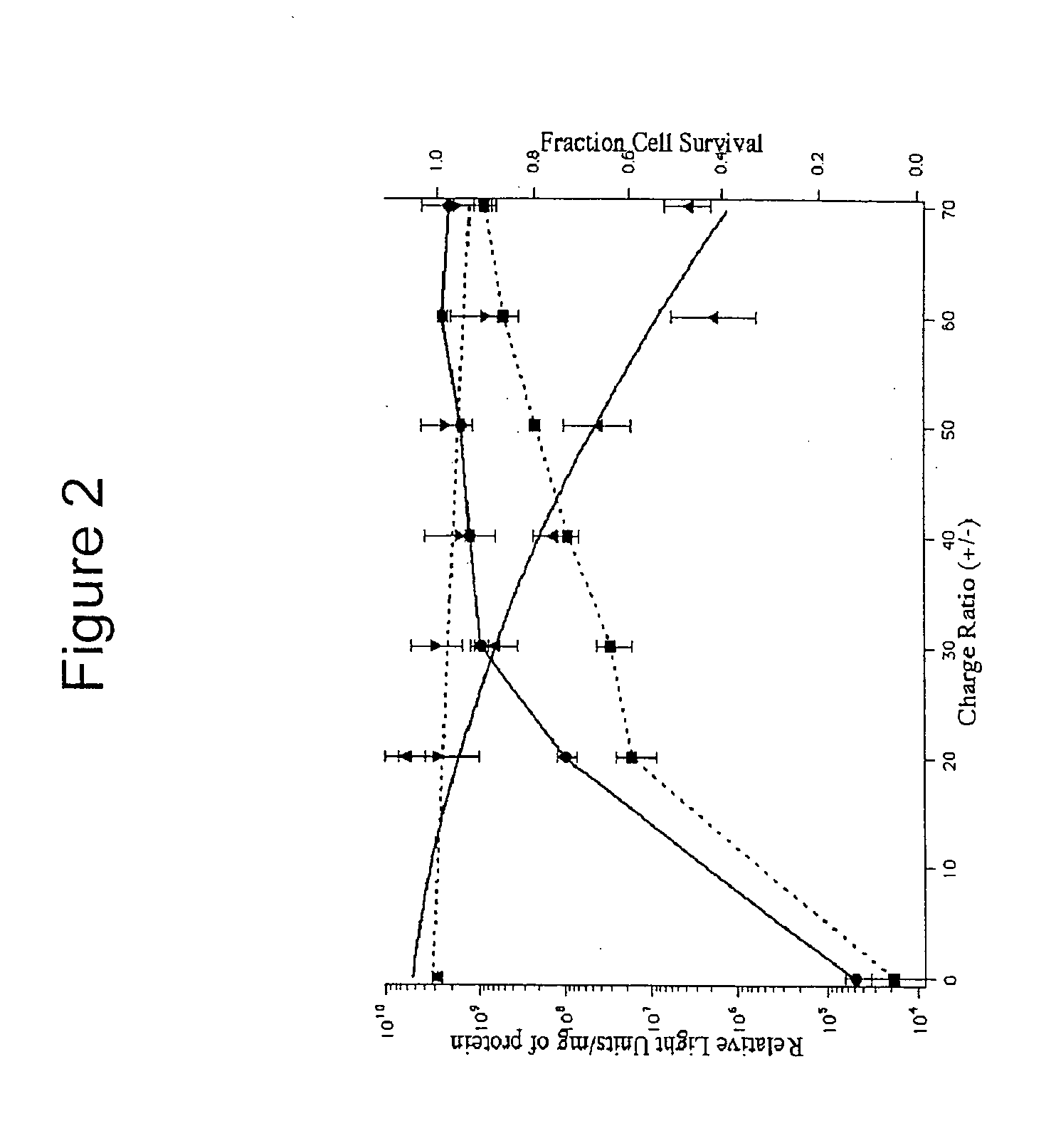Methods and compositions for therapeutic use of RNA interference
a technology of rna interference and composition, which is applied in the direction of aerosol delivery, spray delivery, genetic material ingredients, etc., can solve the problems of affecting the behavior of a disease cell, requiring complex genetic manipulation or heavy dosage of suppressors, and often exceeding the toxicity tolerance level of the host cell
- Summary
- Abstract
- Description
- Claims
- Application Information
AI Technical Summary
Benefits of technology
Problems solved by technology
Method used
Image
Examples
example 1
Delivery of Plasmid DNA Encoding siRNA In Vitro
[0279]Human embryonic kidney cells (HEK 293-EcR) were seeded at 200,000 cells per well in 6-well plates. These HEK 293-EcR cells have been stably transfected with a plasmid encoding the ecdysone receptor. After 2-3 days, the cells were co-transfected with pIND-rev-GFP (a plasmid encoding inducible elements as well as green fluorescent protein) and pTZU6+1 / siRNA (a plasmid encoding the sense and antisense strands of the siRNA oligonucleotides). The plasmids (see, Lee et al. (2002) Nature Biotechnology, 20:500-505) were complexed with branched PEI25k-CD polymer at a ratio of 15 N / P in 0.5 ml of opti-MEM. After 4 hours, the media was replaced with 2 ml of complete media. At 24 hours, the cells were induced with 5 μM ponasterone A to induce the GFP target gene expression. At 72 hours, the cells were removed by versene, collected, and analyzed for GFP expression by flow cytometry. As shown in FIG. 1, transfection of the siRNA down-regulated ...
example 2
DNA Plasmid Delivery and Luciferase Expression In Vitro
[0280]BHK-21 cells were plated in 24-well plates and transfected under serum-free conditions with 1 μg of the pGL3-CV plasmid (a luciferase gene-containing plasmid) complexed with β-cyclodextrin polymers (βCDP6) at various charge ratios. Transfection efficiencies were determined by assaying for luciferase protein activity, with results reported in relative light units (RLUs) (see FIG. 2). The amount of protein in cell lysates obtained 48 hours after transfection was used as a measure of cell viability. Protein levels of transfected cells were determined by Biorad's DC protein assay (Hercules, Calif.) and normalized with protein levels of cells transfected with naked DNA. A protein standard curve was run with various concentrations of bovine IgG (Biorad) in Cell Culture Lysis Buffer. The above experiments demonstrate that transfection efficiencies can be optimized by adjusting the charge ratio between β-cyclodextrin polymers and ...
example 3
DNA Plasmid Delivery and Luciferase Expression in Mice
[0281]All materials except DNA were sterilized by filtration through a 0.2 μm filter and lyophilized before use. Linear cyclodextrin polymer was prepared in 10% glucose and then added to an equal volume of the pGL3-CV plasmid (a luciferase-gene-containing plasmid) in water such that the final solutions are in 5% glucose solutions. Particles were prepared at 5+ / − and at a final DNA concentration of 0.5 mg / mL. Female Balb / C mice were injected via portal vein injection with 200 μL of polymer solution containing 100 μg of luciferase DNA. Four hours after DNA administration, mice were anesthesized, injected with luciferin in the intraperitoneal cavity, and imaged for luciferase protein activity using a Xenogen camera. Luciferase expression was observed in the liver within 4 hours after plasmid administration. The above experiments demonstrate that nucleic acid constructs complexed with β-cyclodextrin polymers can be delivered in vivo ...
PUM
| Property | Measurement | Unit |
|---|---|---|
| Diameter | aaaaa | aaaaa |
| Diameter | aaaaa | aaaaa |
| Diameter | aaaaa | aaaaa |
Abstract
Description
Claims
Application Information
 Login to View More
Login to View More - R&D
- Intellectual Property
- Life Sciences
- Materials
- Tech Scout
- Unparalleled Data Quality
- Higher Quality Content
- 60% Fewer Hallucinations
Browse by: Latest US Patents, China's latest patents, Technical Efficacy Thesaurus, Application Domain, Technology Topic, Popular Technical Reports.
© 2025 PatSnap. All rights reserved.Legal|Privacy policy|Modern Slavery Act Transparency Statement|Sitemap|About US| Contact US: help@patsnap.com



